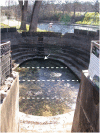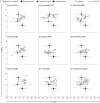Application of stable isotope analysis to study temporal changes in foraging ecology in a highly endangered amphibian
- PMID: 23341920
- PMCID: PMC3546114
- DOI: 10.1371/journal.pone.0053041
Application of stable isotope analysis to study temporal changes in foraging ecology in a highly endangered amphibian
Abstract
Background: Understanding dietary trends for endangered species may be essential to assessing the effects of ecological disturbances such as habitat modification, species introductions or global climate change. Documenting temporal variation in prey selection may also be crucial for understanding population dynamics. However, the rarity, secretive behaviours and obscure microhabitats of some endangered species can make direct foraging observations difficult or impossible. Furthermore, the lethality or invasiveness of some traditional methods of dietary analysis (e.g. gut contents analysis, gastric lavage) makes them inappropriate for such species. Stable isotope analysis facilitates non-lethal, indirect analysis of animal diet that has unrealized potential in the conservation of endangered organisms, particularly amphibians.
Methodology/findings: I determined proportional contributions of aquatic macroinvertebrate prey to the diet of an endangered aquatic salamander Eurycea sosorum over a two-year period using stable isotope analysis of (13/12)C and (15/14)N and the Bayesian stable isotope mixing model SIAR. I calculated Strauss' dietary electivity indices by comparing these proportions with changing relative abundance of potential prey species through time. Stable isotope analyses revealed that a previously unknown prey item (soft-bodied planarian flatworms in the genus Dugesia) made up the majority of E. sosorum diet. Results also demonstrate that E. sosorum is an opportunistic forager capable of diet switching to include a greater proportion of alternative prey when Dugesia populations decline. There is also evidence of intra-population dietary variation.
Conclusions/significance: Effective application of stable isotope analysis can help circumvent two key limitations commonly experienced by researchers of endangered species: the inability to directly observe these species in nature and the invasiveness or lethality of traditional methods of dietary analysis. This study illustrates the feasibility of stable isotope analysis in identifying preferred prey species that can be used to guide conservation management of both wild and captive food sources for endangered species.
Conflict of interest statement
Figures





Similar articles
-
Variable δ(15)N diet-tissue discrimination factors among sharks: implications for trophic position, diet and food web models.PLoS One. 2013 Oct 17;8(10):e77567. doi: 10.1371/journal.pone.0077567. eCollection 2013. PLoS One. 2013. PMID: 24147026 Free PMC article.
-
Stable isotopes confirm a coastal diet for critically endangered Mediterranean monk seals.Isotopes Environ Health Stud. 2014;50(3):332-42. doi: 10.1080/10256016.2014.931845. Epub 2014 Jul 11. Isotopes Environ Health Stud. 2014. PMID: 25014121
-
Sustained use of marine subsidies promotes niche expansion in a wild felid.Sci Total Environ. 2024 Mar 1;914:169912. doi: 10.1016/j.scitotenv.2024.169912. Epub 2024 Jan 5. Sci Total Environ. 2024. PMID: 38184259
-
Predation impacts of invasive raccoons on rare native species.Sci Rep. 2020 Nov 30;10(1):20860. doi: 10.1038/s41598-020-77016-y. Sci Rep. 2020. PMID: 33257676 Free PMC article.
-
Stable isotope analysis in primatology: a critical review.Am J Primatol. 2012 Nov;74(11):969-89. doi: 10.1002/ajp.22053. Am J Primatol. 2012. PMID: 23015270 Review.
Cited by
-
Seasonal variations in diet composition, diet breadth and dietary overlap between three commercially important fish species within a flood-pulse system: The Tonle Sap Lake (Cambodia).PLoS One. 2018 Jun 18;13(6):e0198848. doi: 10.1371/journal.pone.0198848. eCollection 2018. PLoS One. 2018. PMID: 29912953 Free PMC article.
-
Density-dependent and density-independent drivers of population change in Barton Springs salamanders.Ecol Evol. 2018 May 4;8(11):5912-5923. doi: 10.1002/ece3.4130. eCollection 2018 Jun. Ecol Evol. 2018. PMID: 29938103 Free PMC article.
-
Subterranean movement inferred by temporary emigration in Barton Springs salamanders (Eurycea sosorum).PeerJ. 2021 Apr 23;9:e11246. doi: 10.7717/peerj.11246. eCollection 2021. PeerJ. 2021. PMID: 33981501 Free PMC article.
-
Effects of demineralization on the stable isotope analysis of bone samples.Rapid Commun Mass Spectrom. 2015 Oct 30;29(20):1879-88. doi: 10.1002/rcm.7295. Rapid Commun Mass Spectrom. 2015. PMID: 26411509 Free PMC article.
-
Stable Isotopes Reveal Trophic Partitioning and Trophic Plasticity of a Larval Amphibian Guild.PLoS One. 2015 Jun 19;10(6):e0130897. doi: 10.1371/journal.pone.0130897. eCollection 2015. PLoS One. 2015. PMID: 26091281 Free PMC article.
References
-
- Cohn JP (1994) Salamanders slip-sliding away or too surreptitious to count? BioScience 44: 219–224.
-
- Burton TM, Likens GE (1975) Salamander populations and biomass in the Hubbard Brook Experimental Forest, New Hampshire. Copeia 1975: 541–546.
-
- Davic RD, Welsh HH (2004) On the ecological roles of salamanders. Annual Reviews of Ecology, Evolution & Systematics 35: 405–434.
-
- Whiles MR, Lips KR, Pringle CM, Kilham SS, Bixby RJ, et al. (2006) The effects of amphibian population declines on the structure and function of Neotropical stream ecosystems. Frontiers in Ecology & the Environment 4: 27–34.
-
- Altig R, Whiles MR, Taylor CL (2007) What do tadpoles really eat? Assessing the trophic status of an understudied and imperiled group of consumers in freshwater habitats. Freshwater Biology 52: 386–395.
Publication types
MeSH terms
Substances
LinkOut - more resources
Full Text Sources
Other Literature Sources

